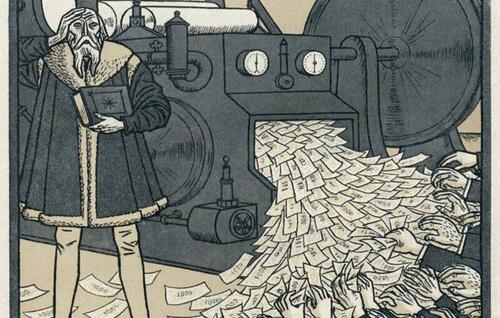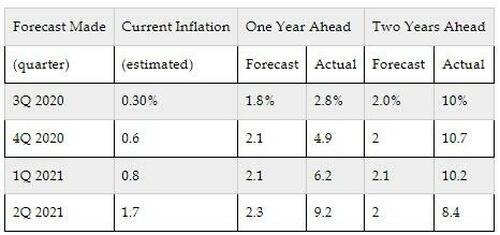
Постоянное искушение всех правительств
Автор: Алекс Поллок via Американский институт экономических исследований,
в Нужно говорить об инфляцииВ своем вдумчивом и доступном путешествии по истории, теориям, политике и будущему инфляции Стивен Кинг предупреждает:
«Инфляция никогда не умирает. "
Он прав в этом, и только это напоминание оправдывает книгу.

Книга начинается, «В 2021 году инфляция возникла в результате многолетней спячки. " Что ж, инфляция на самом деле не была в спячке, а скорее продолжалась темпами, которые стали считаться приемлемыми. Это было беспокойство по поводу инфляции, которая была в спячке. Люди оказались втянутыми в безудержную инфляцию 2021-2023 годов, тревожный звонок. В книге подробно исследуется, что взрывная инфляция была неожиданной для центральных банков, включая Федеральную резервную систему, что делает их прогнозы и гарантии особенно плохими и еще раз доказывает, что их знания о будущем так же бедны, как и у всех остальных.
Сейчас, в третьем квартале 2024 года, после исторически быстрого повышения процентных ставок, текущий уровень инфляции меньше. Но средние цены продолжают расти, поэтому покупательная способность доллара, потерянная из-за инфляции, исчезла навсегда. Инфляция продолжается и продолжает превышать 2-процентную «целевую» ставку ФРС. И сама цель ФРС странная: она обещает создать инфляцию навсегда. Математика сокращения на 2% показывает, что ФРС хочет обесценить покупательную способность доллара на 80% в течение каждого среднего срока службы. Федрезерв почему-то никогда не упоминает об этом.
Кинг показывает нам, что такое долгосрочное исчезновение покупательной способности происходило исторически. В главе 2 «История инфляции, денег и идей» (A History of Inflation, Money and Ideas) начинается обсуждение истории, вариаций и актуальности количественной теории денег. В нем также содержится поучительная таблица стоимости британского фунта к столетию с 1300 по 2000 год. Чемпионом века по амортизации фунта стал двадцатый. Фунт начинался как доминирующая глобальная валюта и заканчивался как также-ран, в то время как один фунт 1900 года уменьшился в стоимости до двух пенсов к 2000 году. В этом столетии была Великая инфляция 1970-х годов, во время которой британский премьер-министр Гарольд Уилсон объявил, что «он надеялся снизить инфляцию до 10 процентов к концу 1975 года и до менее 10 процентов к концу 1976 года». Его надежды были разочарованы, как сардонически сообщает Кинг: "Фактические цифры составили соответственно 24,9 процента и 15,1 процента. "
Эти инфляционные времена нужно помнить, как и многочисленные гиперинфляции. Наиболее известна немецкая гиперинфляция 1921—23 годов, память о которой породила знаменитый антиинфляционный режим старого Бундесбанка. (Однажды остроумно было сказано, что «не все немцы верят в Бога, но все они верят в Бундесбанк» — однако это не относится к его преемнику, Европейскому центральному банку.) Кинг также рассказывает, что последствия Первой мировой войны породили три другие крупные гиперинфляции 1920-х годов — в Австрии, Венгрии и Польше, и что «инфляция в зарождающемся Советском Союзе, по-видимому, была стратосферной». Он обсуждает гиперинфляцию 1940-х годов в Китае и то, как в 1980-х годах «Бразилия и другие латиноамериканские экономики... Поддался гиперинфляции, валютному коллапсу и, в конце концов, дефолту». Мы должны добавить инфляционные катастрофы в Аргентине и Зимбабве.
Все эти разрушительные события стали результатом действий правительств и их центральных банков. В книге рассматривается теория о том, как положить конец этой проблеме, которую в 1982 году сделал лауреат Нобелевской премии экономист Томас Сарджент. В первую очередь, как описал Кинг, это «создание независимого центрального банка, «законно приверженного отказу от требования правительства о дополнительном необеспеченном кредите» — другими словами, не должно было быть дефицитного финансирования через печатание денег». Хорошая идея, но насколько вероятна эта сцена в реальной жизни? Центральный банк говорит правительству: «Извините за вашу просьбу, но мы не покупаем ни копейки вашего долга за деньги, которые мы создаем. Конечно, мы могли бы это сделать, но не будем, поэтому сократите расходы. Удачи! Вероятно, это не победный карьерный ход для политически назначенного центрального банка и не очень вероятный ответ.
Более того, во время войны или другого чрезвычайного положения вероятность такого ответа равна нулю. Война является самым большим источником печатания денег и инфляции. Война и центральный банк идут вместе: Банк Англии был создан в 1694 году для финансирования войн короля Уильяма, был ключевой опорой последующей имперской карьеры Великобритании, а в 1914 году обманным путем поддержал первый выпуск облигаций войны Казначейством Его Величества. Федеральная резервная система была добровольным слугой Казначейства США в обеих мировых войнах и будет снова, когда это будет необходимо. В ходе масштабного военного финансирования дефицита государственного бюджета в период кризиса 2020-2021 годов ФРС совместно купила триллионы казначейских долгов для финансирования расходов правительств на закрытие крупных сегментов экономики.
Размышляя о постоянном искушении правительств раздувать и обесценивать свои валюты, Кинг справедливо замечает:
«Инфляция — это в значительной степени политический процесс. "
«Оставленные на произвол судьбы, правительства не могут не поддаться искушению инфляции. "
«Правительства могут и будут прибегать к инфляции. "
Продолжая процесс инфляции, правительства могут конфисковать, тайно и незаметно, важную часть богатства своих граждан. (перенаправлено с «J.M. Keynes»)
Точно так же, как экономика всегда является политической экономикой, а финансы всегда являются политическими финансами, центральный банк не может избежать того, чтобы быть политическим центральным банком. В книге подробно рассматривается неизбежное взаимодействие между государственными расходами и долгом, с одной стороны, и созданием денег и инфляцией, с другой — в экономическом жаргоне, между фискальной и денежно-кредитной политикой. Теоретически между ними может быть прочный барьер, расходы и налогообложение, осуществляемые в законодательной и исполнительной ветвях власти, и печать денег, или нет, под контролем центрального банка. На практике они встречаются и переплетаются. Кинг называет это проблемой Бертона-Тейлора. Вот его метафора:
«История предлагает бесчисленные примеры, в которых фискальная целесообразность превосходит денежную стабильность. Два больших макроэкономических рычага являются экономическим эквивалентом Элизабет Тейлор и Ричарда Бертона, голливудских звезд, которые были дважды женаты и дважды разведены и которые были, возможно, все еще влюблены, когда Бертон умер. "
Действительно, стремление правительств к дефицитным расходам и готовому инструменту печатания денег и инфляции всегда обречено на воссоединение.
Это отражает фундаментальную дилемму всех политиков: они, естественно, хотят тратить больше денег, чем им нужно для осуществления своих планов, включая войны. «Военное время дает окончательное доказательство полезной роли инфляции как скрытого налога». Политики хотят выполнять свои, возможно, щедрые обещания своим избирателям, вознаграждать своих друзей, укреплять свою власть, переизбираться; им гораздо меньше нравится делать людей несчастными, облагая их налогами. Простой ответ в любой краткосрочной перспективе — брать кредиты для финансирования дефицита и увеличивать государственный долг. Когда заимствования становятся дорогими или становятся недоступными, неизбежно возникает идея просто напечатать деньги, Центральный банк призван, и происходит еще один брак Бертона-Тейлора.
Просто печатать желаемые деньги — это очень старая идея. Как обсуждается в книге, эта часто практикуемая, часто катастрофическая старая идея была продвинута заново — теперь под глупым названием «Современная» денежная теория.
Кинг пишет:
«Печатный станок является искушением [я бы сказал, неизбежным искушением] именно потому, что он является альтернативой повышению налогов или сокращению расходов, скрытым способом в краткосрочной перспективе ограбления людей их сбережений... В конце концов, нет выхода из «Бертон-Тейлор».
Когда правительства и центральные банки поддаются этому искушению, могут ли центральные банки правильно предвидеть инфляционные результаты? Обладают ли они необходимыми знаниями? Очевидно, что ответ - нет.
В главе 6 книги «Четыре инфляционных теста» приводится поучительный пример неудачных прогнозов инфляции Банка Англии, к которым я добавил фактические результаты.

Чтобы применить американскую метафору к этим британским результатам, это четыре забастовки подряд. Отчет по прогнозированию инфляции Федеральной резервной системы представляет аналогичные неудачи.
Центральные банки прилагают все усилия, в том числе крупные политические и общественные усилия, чтобы укрепить свой авторитет. Они хотят управлять денежной системой, в которую все верят.
Но предположим, что все, включая членов Конгресса, вместо того, чтобы верить, развили реалистичное понимание существенных и неизбежных ограничений центральных банков. Предположим, все просто предположили, что центральные банки не могут знать будущее или будущие результаты своих собственных действий. Предположим, как выразился Кинг, у всего общества было «новое эмпирическое правило... Центральные банки не знают, что они делают. "" Рациональные ожидания отражают это предположение.
В этом случае центральные банки будут менее престижными. Будет ли улучшена наша денежная система? Я думаю, что это было бы. Нужно говорить об инфляцииСреди многих других интересных идей, побуждает нас представить такой сценарий.
Тайлер Дерден
Sat, 08/24/2024 - 18:40












